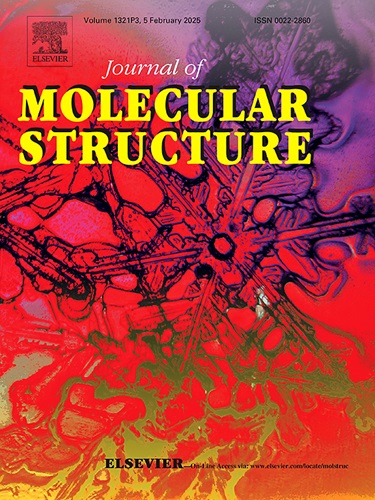Anti-neuroinflammatory sesquiterpene lactones from Achillea millefolium L
IF 4
2区 化学
Q2 CHEMISTRY, PHYSICAL
引用次数: 0
Abstract
Achillea millefolium L. is a medicinal plant traditionally used in the treatment of inflammation-related diseases. Sixteen sesquiterpene lactones, including twelve previously undescribed ones were isolated from the whole plant of A. millefolium. Their structures were established using spectroscopic techniques, including HRMS and NMR, and by comparing with literature. The absolute configuration of these compounds was determined by means of single-crystal X-ray crystallography, 13C NMR calculations with DP4+ probability analyses, and ECD calculations. Millefoliumine R (1), millefoliumine S (2), millefolacton H (6), millefolacton B12 (11), and achalplide a (13) displayed inhibitory activity against NO release in LPS-induced BV2 microglial cells, and millefoliumine S (2) presented the most significant activity with IC50 value close to that of the positive control, dexamethasone. Furthermore, enzyme-linked immunosorbent assay disclosed that millefoliumine S (2) inhibited the release of TNF-α, IL-6, and PGE2 from LPS-induced BV2 cells in a dose-dependent manner. Western blot and immunofluorescence assays revealed that millefoliumine S (2) inhibited the expression of iNOS/COX2 signaling-related proteins (iNOS and COX2), NF-κB signaling-related proteins (NF-κB and IκB), MAPK signaling-related proteins (MAPK, JNK, and ERK), and pyroextinction signaling-related proteins (NLRP3, cleavaged-caspase 1, ASC and IL-1β). Additionally, the potential mechanisms of NO inhibition of millefoliumine S (2) were investigated by molecular docking and molecular dynamics simulation.

千叶水蛭抗神经炎倍半萜内酯
千叶阿喀琉叶是一种药用植物,传统上用于治疗炎症相关疾病。从千叶全株中分离得到16个倍半萜内酯,其中12个为首次报道。利用HRMS和NMR等光谱技术,并与文献进行比较,确定了它们的结构。通过单晶x射线晶体学、DP4+概率分析的13C核磁共振计算和ECD计算确定了这些化合物的绝对构型。千叶胺R(1)、千叶胺S(2)、千叶胺H(6)、千叶胺B12(11)、千叶胺a(13)对lps诱导的BV2小胶质细胞的NO释放有抑制作用,其中千叶胺S(2)的抑制作用最显著,IC50值接近阳性对照地塞米松。此外,酶联免疫吸附试验显示,千叶明S(2)以剂量依赖性的方式抑制lps诱导的BV2细胞释放TNF-α、IL-6和PGE2。Western blot和免疫荧光检测显示,千叶明S(2)抑制iNOS/COX2信号相关蛋白(iNOS和COX2)、NF-κB信号相关蛋白(NF-κB和i -κB)、MAPK信号相关蛋白(MAPK、JNK和ERK)和热灭信号相关蛋白(NLRP3、裂解caspase 1、ASC和IL-1β)的表达。此外,通过分子对接和分子动力学模拟研究NO抑制千叶胺S(2)的潜在机制。
本文章由计算机程序翻译,如有差异,请以英文原文为准。
求助全文
约1分钟内获得全文
求助全文
来源期刊

Journal of Molecular Structure
化学-物理化学
CiteScore
7.10
自引率
15.80%
发文量
2384
审稿时长
45 days
期刊介绍:
The Journal of Molecular Structure is dedicated to the publication of full-length articles and review papers, providing important new structural information on all types of chemical species including:
• Stable and unstable molecules in all types of environments (vapour, molecular beam, liquid, solution, liquid crystal, solid state, matrix-isolated, surface-absorbed etc.)
• Chemical intermediates
• Molecules in excited states
• Biological molecules
• Polymers.
The methods used may include any combination of spectroscopic and non-spectroscopic techniques, for example:
• Infrared spectroscopy (mid, far, near)
• Raman spectroscopy and non-linear Raman methods (CARS, etc.)
• Electronic absorption spectroscopy
• Optical rotatory dispersion and circular dichroism
• Fluorescence and phosphorescence techniques
• Electron spectroscopies (PES, XPS), EXAFS, etc.
• Microwave spectroscopy
• Electron diffraction
• NMR and ESR spectroscopies
• Mössbauer spectroscopy
• X-ray crystallography
• Charge Density Analyses
• Computational Studies (supplementing experimental methods)
We encourage publications combining theoretical and experimental approaches. The structural insights gained by the studies should be correlated with the properties, activity and/ or reactivity of the molecule under investigation and the relevance of this molecule and its implications should be discussed.
 求助内容:
求助内容: 应助结果提醒方式:
应助结果提醒方式:


